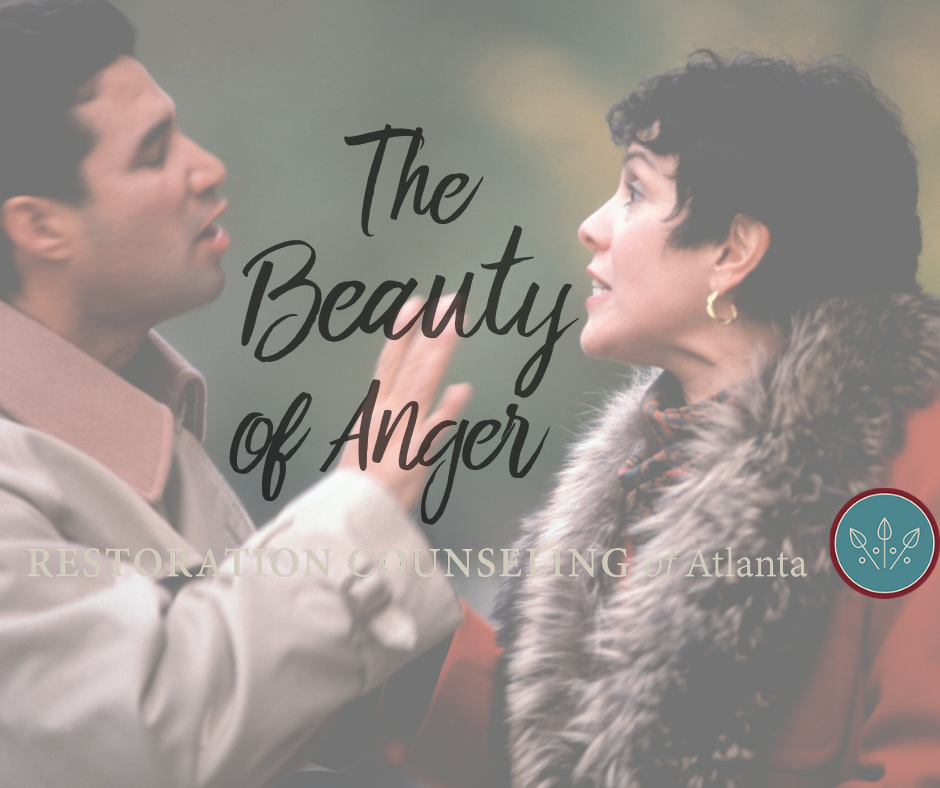The Beautiful Design of Anger
“I don’t really get angry.”
Have you found yourself uttering those words before? Many of us pride ourselves on not being an angry person. It feels good to be a person who was able to avoid this emotion that seemed to cause so much harm and result in such embarrassing behavior.
Or perhaps you find yourself on the other end of the spectrum. You find yourself quick to explode, quick to snap with a sharp retort, and quick to share certain gestures on the highway to declare your disapproval to those impacting you.
“Be angry, but do not sin” seems to be Paul acknowledging the normalcy of feeling angry — even expecting that we will or calling us toward anger being an appropriate response to living in a fallen world — while also encouraging us to master our anger rather than allowing it to master us.
Regardless of whether you find yourself in one of these polarities or somewhere in between, I hope that you will go on this journey with me to explore the innate beauty of anger and begin to see and embrace the purpose within the good design of anger.
The Harm of Anger Polarities
Over-Controlled Stance
Unhinged anger can be really scary. It is no wonder many of us want to divorce ourselves from this unsettling emotion. We have seen others say or take impulsive actions that result in embarrassment, regret, or consequences. We have seen or been on the receiving end of harsh words or volatile actions that make us vow to never resemble such behavior. And yet, though at first glance this stance seems like the “right” one, it can come at a cost that we do not even realize. This stance assumes that all anger is bad and should be pushed out of existence within us. We seek to cut out any hint of anger and banish those feelings to the deepest corners of our being hoping with fingers crossed that they will eventually dissipate for good. Many of us learned early on that expressing anger resulted in negative consequences, and as a result, we became so skilled at ignoring our anger that we automatically defend against it with a variety of cognitive strategies that may even be outside of our awareness.
While it makes sense to desire to avoid destructive anger, it can be equally as damaging to silence or extinguish our anger. It can result in a stifled initiative, diminished will power, poor boundaries, passivity, undeveloped opinions, depression, anxiety, a harsh internal critic, and numerous physical ailments. Despite our likely desire to protect our relationships through dismissing or disregarding our anger, it can also negatively impact our relationships in a variety of ways by undermining heart-level honesty.
Under-Controlled Stance
Those in the opposite camp likely know all too well the impact that unrestrained or constantly boiling anger can have on relationships. This side of the continuum can result in significant shame and guilt as a result of the destruction that can come with an unfettered expression of anger. We can find ourselves snapping at our kids, destroying property, causing physical harm to ourselves or others, and losing our jobs as a result of overwhelming anger that we did not learn how to navigate. Long term anger similarly to disregarded anger can produce physical ailments as well such as high blood pressure, heart attacks, depression, anxiety, headaches, obesity, and more.
Efforts to restrain on this end often result in more shame and guilt due to primarily focusing on will power rather than seeking to resolve the reasons the anger is surfacing in the first place. We seek to do better and try harder only to be wracked with self-contempt and self-disgust over our failure to get control of something that is causing so much pain in our lives.
Thankfully, we have a good Designer that built His world to provide subtle feedback cues when we miss the fullness of his good design. Anger is no exception. He has provided small clues to provide us information to let us know when we are off base. These little indicators give us a sign that something isn’t quite right. They give us warning lights on our dashboard beckoning us to pay attention.
Good Design of Anger
Theologically
As mentioned earlier, the Bible seems to expect that anger will be a normal part of the human experience. It seems to expect that to be human is to experience anger, and as a result, we are not called to never feel anger, but rather to not sin while feeling it. Now, this is a high call, and as human beings, we are learning through failing forward on the right trajectory. This process produces humility and patience, as well as increasing our ability to extend mercy, grace, and long-suffering to others as we have thoroughly experienced our need to receive these as well.
The Bible repeatedly mentions God experiencing anger which puts those of us that struggle to want to feel anger in a bit of a dilemma. These references are not even relegated only to the Old Testament where God seems a bit scarier, but rather it extends to Jesus as well who is described to have looked upon those around him in anger in Mark 3:5. With this in mind, it seems as though we are safe to venture into the waters of anger with a God who understands and can help begin to shape that anger to look more like His if we learn how to bring it into a relationship with ourselves, Him, and others in a productive way.
Physiologically
Our created body speaks to being designed to work through emotions rather than to allow them to rule our lives. Emotions are quite literally energy within our bodies. This is true, especially with anger. We can feel it coursing through our veins begging to be let out. It is a significant amount of energy to contain and swallow within our body, and the continued attempt to do so results in a breakdown of our physiology. Scientific research continues to show connections between our emotions and our physical wellbeing. Each article hinting at researchers observing realities woven into the fabric of how this world was created.
These connections speak to the purposes behind the beauty of God’s design of anger and how it impacts our body if we avoid learning to align our lives up with how He designed things to function. Anger helps us identify relational needs, protect against harm, grieve, pursue justice, set boundaries to restrain evil, builds healthy aggression to step into the life God has called us into, fosters fully developing a self, helps embrace and extend freedom, and many additional benefits. Tall these functions are viewed through a relational lens and contribute to maintaining a relationship in a manner that is honoring to both parties and thus fosters trust – the vital component of healthy relationships.
Making Friends with Anger
The groundwork is in place to begin our next step. We have seen the beauty of God’s design and how He created our body to reflect these truths. In addition, we have seen His expression of anger and the goodness and purpose behind it. We have also seen how operating outside of this design with over- or under-controlled anger can result in poor outcomes health-wise and relationally.
Practice noticing
If you tend to disregard your anger, it can be helpful to begin to think of anger as being on a spectrum. We want to practice noticing our “I don’t like this,” or our feelings of being annoyed, irritated, and frustrated. These are baby steps into the fullness of our anger and beginning to acknowledge these moments can help as we learn to notice our experiences of anger. If instead, you struggle with your anger exploding, it can be helpful to begin to notice additional nuances to our anger such as feeling betrayal, disrespect, misunderstood, and suspicious to expand our understanding of the contributing factors underneath our anger that may also need attention.
An additional component to noticing is paying attention to the physical sensations you notice during these moments of anger being identified. Sensations such as feeling hot, tightness in your chest, tense muscles, sweating, and more. These physical cues can clue you in to the fact that something is bothering you. Your body is automatically gearing up to fight against or flee from a perceived (or actual) wrong being perpetrated against you
Practice lowering intensity
When anger is new or explosive, the intensity can be a little unsettling. It can take time to learn ways to decrease the loudness of the sensations you are experiencing. It can be helpful to experiment with a variety of coping strategies to distract and bring the sensations into a more manageable level before beginning to evaluate the experience. This pause aids in lowering the risk of taking unwanted action via words or behaviors in reaction to the experience, and instead, increases the ability to respond. Utilizing the five senses can be a helpful way to pull your attention to the present moment such as noticing and describing smells, sights, sounds, touch, and tastes to help shift your focus. Another helpful way of expelling the pent-up energy of anger is working out. This type of active engagement can also look like balling up socks/playdoh and chucking them at the wall or taking pieces of paper and ripping them while putting words to your anger. These new ways to experiment can provide constructive options to work through the energy you are experiencing so you can listen and attend to it rather than be overcome and controlled by it.
Practice sharing
Lastly, the process of learning control and pursuing maturity occurs within the context of relationships. The previous two steps can also be explored within the context of the relationship with God and others, but this final step is to practice sharing our anger in ways that improve relationships rather than erode them. Others have no possibility of adjusting to our needs if they are unaware of those needs. Practicing conversations with a neutral third party can be helpful to find the right words and process additional emotions that may surprisingly surface during the conversation. Sharing (even with a third party) begins to drag parts of our experience into relationships that have been banished to isolation. It is within a relationship that these parts of us begin to learn new skills, mature, and begin to shift from how they learned to function to how they were designed to function. As we gain connection and skill, we learn to directly express our anger in a way that does not seek to control, bulldoze, or manipulate, but rather in a way that builds our self-control, responsibility, and healthy aggression – all of which continue to develop deeper intimacy and maturity.
Writte n by: Becca Cline, LPC
n by: Becca Cline, LPC
Roswell and Buckhead Locations
becca@restorationcounselingatl.com, ext. 156
Becca has received extensive training with Dr. John Townsend, New York Times best selling author of Boundaries and has completed training in his Competence + Character growth model. She is currently completing the Townsend Leadership Program, which focuses on achieving strategic goals to pursue improved performance personally and professionally.
Becca works with male and female clients who are 13 years or older. She sees couples, families, and individuals. Also, she has worked with clients dealing with a variety of issues including depression, anxiety, addiction, grief/loss, trauma, abuse, spiritual issues, sexuality, family of origin issues, codependency, anger, and interpersonal and relationship issues. In addition, Becca also has experience in running process groups.

